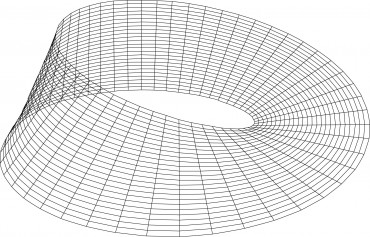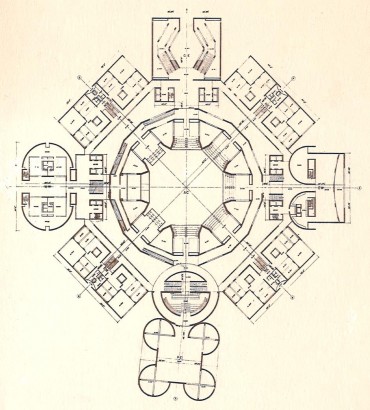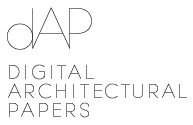
Moebius Strip Illustration after Paul Bourke

Aldo van Eyck, “The Child, the City and the Artist“ (1962), manuscript; Architectural Archives, University of Pennsylva

Invitation Card to the exhibition “The Architecture of Louis I. Kahn“, The Museum of Modern Art, New York, 1966
16.7.2014 – Issue 16 - Identity & Modernity – Sauter Florian, Pallasmaa Juhani – Interviews, Videos
Fusion of the Senses
Interview with Juhani Pallasmaa
JP I grew up at my grandfather’s small farm in central Finland, so I have
a farm boy’s mentality. I was the only boy within five kilometres and
had to invent things for myself to do. When you have a lot of time,
there are, of course, endless miracles happening in nature. So, my socalled
phenomenology arises from personal observations as a young
boy, and continues today. I wrote my first philosophical essays before
I even knew and could pronounce the word phenomenology. I have
been drawn into philosophical circles after the fact, which is very
satisfying for someone who has never studied philosophy formally.
Nevertheless, for me, the phenomenological approach, particularly in
the way formulated by Maurice Merleau-Ponty, which implies personal
observation and the direct encounter with reality, is the natural way
of approaching architecture and artistic phenomena. Of course, the
artistic phenomena exist only in the encounter of an individual and
the work; that is where experience arises.
FS This idea of making our encounter with the world more explicit was
particularly important in the 1950s, when people like Aldo van Eyck
looked at places and occasions rather than space and time. What
can this re-mythicised and re-poeticised understanding of the
world teach us today?
JP This is an important approach. I have written a number of times
that architecture should re-eroticise our relationship with the world.
The technological world in particular is becoming totally unerotic,
whereas old settings have an erotic aspect—they support fantasy and
daydreaming. I knew van Eyck quite well, and have great respect for
his attempt to connect the contemporary with the mythological and
anthropological grounds of architecture. It is the early human constructions
that reveal the fundamentals of human experience.
FS You often mention the fundamental duality between architecture
as an expression of the physical world and its subjective, emotional
perception, where the real encounter is enhanced by one’s own imagination,
memories and thoughts. Since Antiquity, we have known
that the natural elements describe real and active macrocosmic
forces, and were used to order the micro-condition of the human
body. This dualism re-emerges in the Renaissance in the image of
the cosmic body, where even the senses are correlated with the elements:
seeing with fire, hearing with air, smelling and tasting with
water, and touching with earth. What role does architecture play in
this dialectic?
JP It’s a historical fact that initially architecture was not just to provide
shelter, but also for the mental and metaphysical purposes of mediating
between the macro- and the microcosm, between gods and mortals.
I believe that this basis of architecture has to be recovered, starting at
schools of architecture. One development that is positively expanding
is understanding the embodied nature of human existence as opposed
to the Cartesian view. Personally, I have learnt gradually that we are
a kind of knot in a rope of fibres that are both physical and mental,
everything at the same time. For me, a helpful image to understand the
intertwining of the material and the mental is the Moebius Strip, which
has two sides but only one surface. I think our mental and material being
is a similar continuum that turns unnoticeably from one state into the
other. An architectural theory or attitude that fully acknowledges human
embodied essence is one of the things I eventually want to develop.
Ultimately, it’s a combination of the philosophical-phenomenological point
of view and the neurological understanding of the intertwining. We are not
seeing and hearing and smelling and tasting and touching animals—
all of that takes place at the same time.
FS To adopt an extreme position, could we consider the artfully tectonic,
material answer to these pragmatic urgencies as the highest
form of architectural articulation?
JP First of all, it’s not a dualism; it’s a coexistence. Secondly, yes, I
think it is the true language of architecture to make things explicit. In
the case of rain, for instance, a roof is a very powerful architectural
element, but modernity has eliminated the roof; it is strange that
architecture would give up such a powerful element. In a profound
building, the poetic and the pragmatic are the same thing. In general,
I observe that architecture is threatened by two opposing forces: one
is complete instrumentalisation, the other is complete aestheticisation.
Both are disasters for architecture: the first takes away the poetic
and mythical dimension, and the second removes the pragmatic
routine of the reality of things.
FS You once quoted Rainer Maria Rilke, who said: “Verses are not, as
people imagine, simply feelings—they are experiences.” What about
architecture? Can you learn architectural poetry at school?
JP Great poets and writers grow like plants. Of course, literature is
taught in universities, but literary talents are autonomous. Architecture
is being and can be taught, but again, real architects grow like
plants. Architecture does not arise from aesthetics or disciplinary
rules; it arises from understanding and feeling life—the wisdom of life.
That’s probably why there are very few early geniuses in architecture;
most do their best works later in life, like Louis Kahn in Dhaka—a
building that almost knocked me off my feet, it was so powerful. A
building like that could not be designed by a young mind; it needed
a mind that had already lived. What I am suggesting here is that architects
should read books, be interested in the arts and in life, they
should travel and sketch, but they should also be interested in themselves.
It’s not about self-expression, though; it’s about the enigma of
defining the architect’s position in the world.
Excerpts from an Interview with Florian Sauter
Download article as PDF

